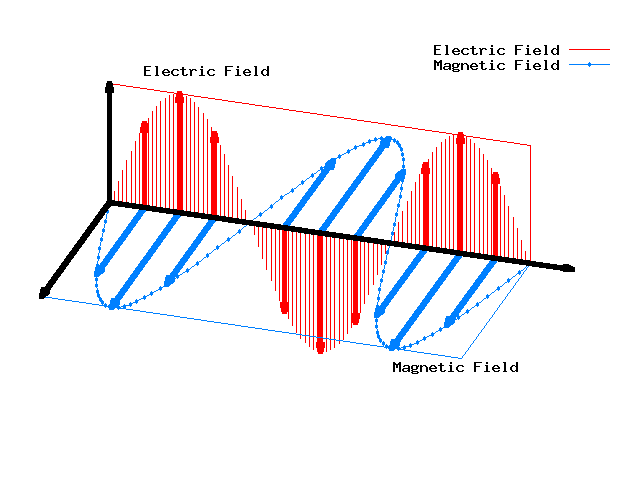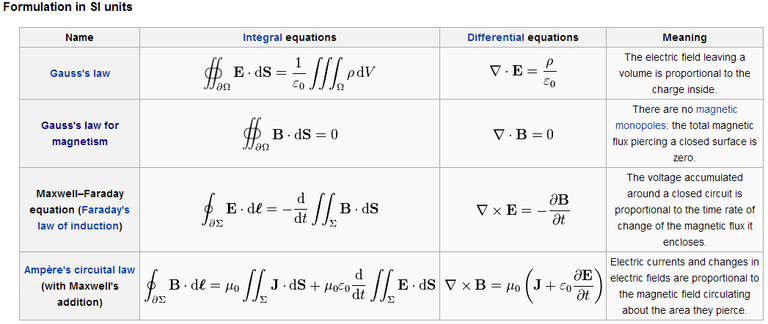Science...
They are still realizing in our day to day, it is integrated.

Electromagnetic radiation is a type of variable electromagnetic field, that is, a combination of oscillating electric and magnetic fields, which propagate through space, transporting energy from one place to another.

From the classical point of view electromagnetic radiation are the electromagnetic waves generated by the sources of the electromagnetic field and that propagate at the speed of light. The generation and propagation of these waves are compatible with the model of mathematical equations defined in Maxwell's equations.

Electromagnetic radiation can manifest itself in different ways such as infrared radiation or IR radiation, is a type of electromagnetic and thermal radiation, longer wavelength than visible light, but less than that of microwaves.
Visible light, visible spectrum is called the region of the electromagnetic spectrum that the human eye is able to perceive. Electromagnetic radiation in this range of wavelengths is called visible light or simply light.
X-rays are electromagnetic radiation of the same nature as radio waves, microwave waves, infrared rays, visible light, ultraviolet rays and gamma rays. The fundamental difference with gamma rays is their origin: gamma rays are radiation of nuclear origin that are produced by the de-excitation of a nucleon from one excited level to another of lower energy and in the decay of radioactive isotopes, while X-rays arise from extranuclear phenomena, at the level of the electronic orbit, fundamentally produced by deceleration of electrons.
Gamma radiation or gamma radiation is a type of electromagnetic radiation, and therefore constituted by photons, usually produced by radioactive elements or by subatomic processes such as the annihilation of a positron-electron pair. It is also generated in astrophysical phenomena of great violence.
Unlike other wave types, such as sound, which need a material medium to propagate, electromagnetic radiation can propagate in a vacuum.
Electrodynamics is the physics of electromagnetic radiation, and electromagnetism is the physical phenomenon associated with the theory of electrodynamics. The electric and magnetic fields obey the properties of superposition. Therefore, a field due to any particular particle or variable electric or magnetic field over time contributes to the fields present in the same space due to other causes. In addition, since they are vector fields, all vectors of magnetic and electric fields are added according to the addition of the vector. In optics two or more coherent light waves can interact and by constructive or destructive interference they produce a resultant irradiance that deviates from the sum of the irradiances components of the individual light waves.
Wave model
Representation of the electric field vector of a wave of circularly polarized electromagnetic radiation. Electromagnetic radiation is a transverse wave, which means that its oscillations are perpendicular to the direction of energy transfer and displacement. The electric and magnetic parts of the field are in a fixed ratio of forces to satisfy the two Maxwell equations that specify how one is produced from the other.

Electromagnetic spectrum
EM radiation (the designation "radiation" excludes static and electric and nearby static fields) is classified by wavelength in radio, microwave, infrared, visible, ultraviolet, X-ray and gamma rays. Arbitrary electromagnetic waves can be expressed by Fourier analysis in terms of sinusoidal monochromatic waves, which in turn can be classified in these regions of the EMR spectrum.

We see how electromagnetic waves are directly and indirectly involved in our daily lives, with the use of tools that are so necessary for humanity today, such as telephones, television, radio, medical tools that are so important and necessary. However we can see that from simple things like these to more complex things like astronomy, thermodynamics and physics in general.
Source
Source Image 1,2,3,4,5,6,7,8,9



 Electromagnetic radiation can manifest itself in different ways such as infrared radiation or IR radiation, is a type of electromagnetic and thermal radiation, longer wavelength than visible light, but less than that of microwaves.
Electromagnetic radiation can manifest itself in different ways such as infrared radiation or IR radiation, is a type of electromagnetic and thermal radiation, longer wavelength than visible light, but less than that of microwaves. 
 Visible light, visible spectrum is called the region of the electromagnetic spectrum that the human eye is able to perceive. Electromagnetic radiation in this range of wavelengths is called visible light or simply light.
Visible light, visible spectrum is called the region of the electromagnetic spectrum that the human eye is able to perceive. Electromagnetic radiation in this range of wavelengths is called visible light or simply light.
 X-rays are electromagnetic radiation of the same nature as radio waves, microwave waves, infrared rays, visible light, ultraviolet rays and gamma rays. The fundamental difference with gamma rays is their origin: gamma rays are radiation of nuclear origin that are produced by the de-excitation of a nucleon from one excited level to another of lower energy and in the decay of radioactive isotopes, while X-rays arise from extranuclear phenomena, at the level of the electronic orbit, fundamentally produced by deceleration of electrons.
X-rays are electromagnetic radiation of the same nature as radio waves, microwave waves, infrared rays, visible light, ultraviolet rays and gamma rays. The fundamental difference with gamma rays is their origin: gamma rays are radiation of nuclear origin that are produced by the de-excitation of a nucleon from one excited level to another of lower energy and in the decay of radioactive isotopes, while X-rays arise from extranuclear phenomena, at the level of the electronic orbit, fundamentally produced by deceleration of electrons.
 Gamma radiation or gamma radiation is a type of electromagnetic radiation, and therefore constituted by photons, usually produced by radioactive elements or by subatomic processes such as the annihilation of a positron-electron pair. It is also generated in astrophysical phenomena of great violence.
Gamma radiation or gamma radiation is a type of electromagnetic radiation, and therefore constituted by photons, usually produced by radioactive elements or by subatomic processes such as the annihilation of a positron-electron pair. It is also generated in astrophysical phenomena of great violence.

